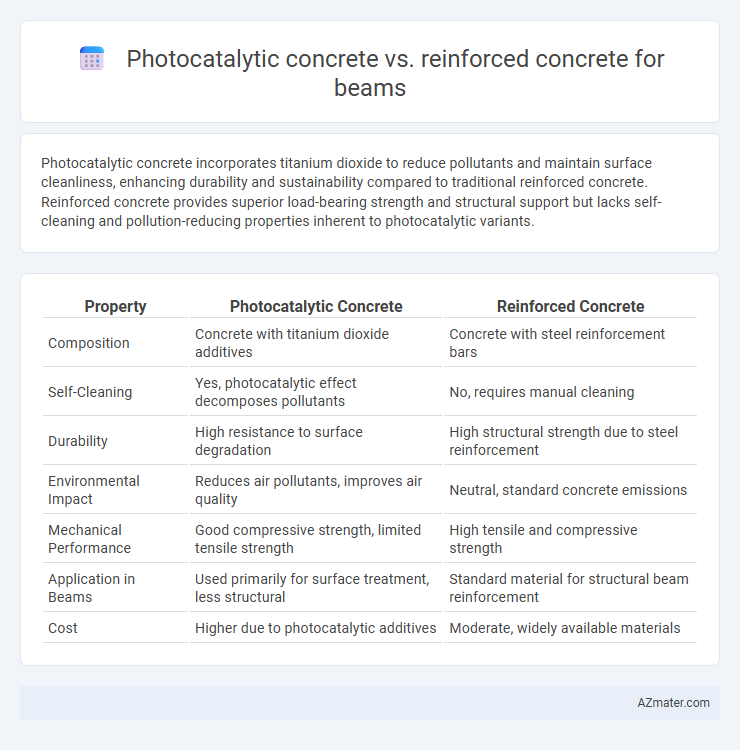Photocatalytic concrete incorporates titanium dioxide to reduce pollutants and maintain surface cleanliness, enhancing durability and sustainability compared to traditional reinforced concrete. Reinforced concrete provides superior load-bearing strength and structural support but lacks self-cleaning and pollution-reducing properties inherent to photocatalytic variants.
Table of Comparison
| Property | Photocatalytic Concrete | Reinforced Concrete |
|---|---|---|
| Composition | Concrete with titanium dioxide additives | Concrete with steel reinforcement bars |
| Self-Cleaning | Yes, photocatalytic effect decomposes pollutants | No, requires manual cleaning |
| Durability | High resistance to surface degradation | High structural strength due to steel reinforcement |
| Environmental Impact | Reduces air pollutants, improves air quality | Neutral, standard concrete emissions |
| Mechanical Performance | Good compressive strength, limited tensile strength | High tensile and compressive strength |
| Application in Beams | Used primarily for surface treatment, less structural | Standard material for structural beam reinforcement |
| Cost | Higher due to photocatalytic additives | Moderate, widely available materials |
Introduction to Photocatalytic and Reinforced Concrete
Photocatalytic concrete integrates titanium dioxide (TiO2) nanoparticles that activate under UV light to break down pollutants, offering self-cleaning and air-purifying properties. Reinforced concrete combines concrete with steel reinforcement bars to enhance tensile strength and structural durability, making it ideal for load-bearing beams. Photocatalytic concrete primarily targets environmental benefits, whereas reinforced concrete emphasizes mechanical integrity and load resistance.
Composition and Material Differences
Photocatalytic concrete incorporates titanium dioxide (TiO2) as a photocatalyst into its cement matrix, enabling it to break down pollutants when exposed to sunlight, whereas reinforced concrete primarily consists of cement, aggregates, water, and steel reinforcement bars that provide tensile strength. The inclusion of TiO2 nanoparticles in photocatalytic concrete alters the material's surface chemistry, enhancing its self-cleaning and air-purifying capabilities without significantly affecting its structural properties. In contrast, reinforced concrete focuses on mechanical performance through the combination of concrete's compressive strength and steel's tensile reinforcement, lacking any photocatalytic or environmental purification functions.
Mechanisms of Structural Performance
Photocatalytic concrete integrates titanium dioxide nanoparticles that catalyze oxidation reactions, enhancing surface self-cleaning and pollutant degradation but slightly affecting compressive strength due to altered microstructure. Reinforced concrete utilizes steel bars embedded within the cement matrix to improve tensile strength and ductility, enabling the beam to resist bending and shear forces effectively. The structural performance of photocatalytic concrete beams depends on the interplay between photocatalytic activity and matrix integrity, whereas reinforced concrete beams rely on the synergy between concrete's compressive capacity and steel reinforcement's tensile resistance.
Environmental Impact and Sustainability
Photocatalytic concrete incorporates titanium dioxide to break down pollutants, improving air quality and reducing urban smog, whereas reinforced concrete primarily focuses on structural strength with limited environmental benefits. The photocatalytic action reduces maintenance needs and extends the lifespan of beams by preventing surface degradation, enhancing sustainability compared to conventional reinforced concrete. However, reinforced concrete's high carbon footprint from cement production contrasts with photocatalytic concrete's potential to mitigate environmental damage through active pollutant reduction.
Durability and Maintenance Requirements
Photocatalytic concrete enhances beam durability by reducing surface pollutants and preventing microcracks through its self-cleaning properties, thereby extending service life and minimizing maintenance needs. Reinforced concrete beams rely on steel reinforcement for structural strength but are susceptible to corrosion and cracking, necessitating regular inspection and maintenance to preserve integrity. Comparing both, photocatalytic concrete offers improved resistance to environmental degradation, reducing long-term upkeep compared to traditional reinforced concrete beams.
Self-Cleaning and Air-Purifying Properties
Photocatalytic concrete integrates titanium dioxide nanoparticles that trigger chemical reactions under sunlight, enabling self-cleaning by breaking down organic dirt and pollutants on beam surfaces, significantly reducing maintenance. Reinforced concrete lacks these photocatalytic properties, requiring regular cleaning and offering no inherent air-purifying benefits. Photocatalytic beams actively degrade airborne nitrogen oxides (NOx), contributing to improved air quality, a feature absent in traditional reinforced concrete structures.
Load-Bearing Capacity and Flexural Strength
Photocatalytic concrete incorporates titanium dioxide, enhancing self-cleaning and pollution-reducing properties without significantly compromising load-bearing capacity compared to traditional reinforced concrete. Reinforced concrete beams, embedded with steel rebars, exhibit superior flexural strength due to enhanced tensile resistance, making them more suitable for high-load structural applications. While photocatalytic concrete offers environmental benefits, reinforced concrete remains the preferred material for beams requiring maximum load-bearing capacity and flexural performance.
Cost Analysis: Installation and Lifecycle
Photocatalytic concrete typically incurs higher initial installation costs due to specialized materials and production processes compared to conventional reinforced concrete beams. However, the self-cleaning and pollutant-degrading properties of photocatalytic concrete can reduce maintenance expenses and extend the lifecycle, potentially lowering long-term costs. Reinforced concrete beams generally have lower upfront costs but may require more frequent repairs and maintenance, increasing total lifecycle expenditure.
Typical Applications in Beam Construction
Photocatalytic concrete is often used in beam construction for urban infrastructure and environmental projects due to its ability to reduce air pollutants and enhance durability in polluted environments. Reinforced concrete beams are typically applied in high-load-bearing structures like bridges, commercial buildings, and residential complexes where strength and structural integrity are crucial. Photocatalytic concrete is preferred in areas requiring self-cleaning and pollution mitigation, while reinforced concrete dominates in standard structural applications demanding high tensile and compressive strength.
Future Trends and Innovations in Concrete Technology
Photocatalytic concrete integrates titanium dioxide nanoparticles that actively break down pollutants, offering self-cleaning and air-purifying properties, which position it as a sustainable innovation for urban infrastructure versus traditional reinforced concrete. Future trends emphasize enhancing photocatalytic efficiency through nanotechnology advancements and improving mechanical strength to meet structural beam requirements while reducing maintenance costs. Innovations such as smart sensors embedded in photocatalytic concrete aim to monitor environmental conditions and structural health, driving the evolution of multifunctional, eco-friendly beam materials in construction.

Infographic: Photocatalytic concrete vs Reinforced concrete for Beam
 azmater.com
azmater.com